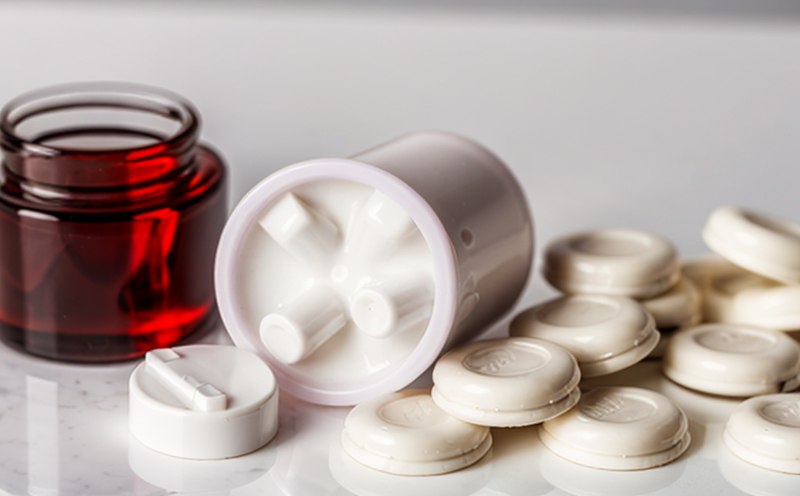USP Effervescent Tablet Disintegration Testing
The USP Effervescent Tablet Disintegration Test is a crucial analytical procedure designed to evaluate the dissolution and disintegration behavior of effervescent tablets under specified conditions. This test ensures that the active pharmaceutical ingredients (APIs) are released efficiently, which is essential for drug efficacy and patient safety.
Effervescent tablets are characterized by their ability to release carbon dioxide gas when in contact with water. The reaction typically involves a combination of citric acid and sodium bicarbonate. During this process, the tablet breaks down into smaller particles, releasing its active ingredients. This disintegration must occur within specific timeframes for the tablet to be effective.
The USP United States Pharmacopeia provides detailed guidelines on how this test should be conducted. The procedure involves placing a known quantity of the effervescent tablet in a specified volume of water at a controlled temperature, typically 37°C ± 1°C. The disintegration is then observed and recorded over time.
The primary objective of this testing is to ensure that the effervescent tablets meet the required quality standards set by regulatory bodies like the FDA (Food and Drug Administration) in the United States. Compliance with these regulations is critical for pharmaceutical manufacturers as it ensures patient safety and product efficacy.
For accurate results, it's important to follow strict procedures during sample preparation and testing. This includes ensuring that the water used is of appropriate quality and temperature, using calibrated instruments, and adhering to precise timing protocols. The test is often conducted in a controlled environment to minimize external variables that could affect the outcome.
The USP disintegration test results are reported based on the time it takes for the tablet to completely disintegrate into small particles or granules. This time can vary depending on the formulation and strength of the tablet. The results are then compared against established standards to ensure compliance with regulatory requirements.
Effervescent tablets, due to their unique dissolution characteristics, pose specific challenges in testing. Understanding these nuances is crucial for accurate testing outcomes. For instance, the reaction between citric acid and sodium bicarbonate can significantly affect the disintegration process, making it imperative to control these variables precisely.
The USP guidelines ensure that such tests are conducted consistently across different laboratories, which enhances reliability and comparability of results. This standardization is vital for maintaining the integrity and consistency of pharmaceutical products in a global market.
Compliance with the USP disintegration test is not just about meeting regulatory requirements; it's also about ensuring patient safety and product efficacy. By adhering to these standards, manufacturers can ensure that their effervescent tablets perform as expected under real-world conditions.
International Acceptance and Recognition
- The USP Effervescent Tablet Disintegration Test is widely accepted by regulatory bodies around the world. It is recognized in countries such as Canada, Mexico, and various European Union member states.
- This test is also used extensively in Australia, New Zealand, and several Asian nations, including India and China, where pharmaceutical standards are closely aligned with international norms.
The widespread acceptance of this test underscores its importance in ensuring the quality and efficacy of effervescent tablets globally. By adhering to these internationally recognized standards, manufacturers can ensure consistent product performance across different markets.
Regulatory bodies outside the United States, such as the European Medicines Agency (EMA) and the Pharmaceuticals and Medical Devices Agency (PMDA) in Japan, also recognize this test due to its robustness and reliability. This recognition ensures that pharmaceutical products meet global standards for safety and efficacy.
Environmental and Sustainability Contributions
The USP Effervescent Tablet Disintegration Test contributes positively to environmental sustainability by ensuring the quality of effervescent tablets, which in turn helps reduce waste. When tablets are not disintegrating correctly, they may remain in the body longer than necessary or be ineffective, leading to potential health risks and increased healthcare costs.
By ensuring that effervescent tablets meet strict disintegration standards, this test supports the development of more effective and safer pharmaceutical products. This, in turn, leads to reduced medical interventions and improved patient outcomes, contributing to a healthier environment by minimizing unnecessary treatments and hospitalizations.
Competitive Advantage and Market Impact
- Innovation and Quality Assurance: Compliance with the USP Effervescent Tablet Disintegration Test can provide significant competitive advantages. It demonstrates a commitment to quality, which is increasingly important in an industry where patient safety and product efficacy are paramount.
- Market Penetration: Meeting regulatory standards opens up opportunities for market penetration. By adhering to international norms, manufacturers can tap into global markets with confidence, knowing that their products meet the highest standards of quality and safety.
The USP Effervescent Tablet Disintegration Test not only ensures compliance with regulatory requirements but also enhances a company's reputation in the industry. This is particularly important for pharmaceutical companies looking to establish themselves as leaders in product quality and innovation.
By adhering to these standards, manufacturers can differentiate their products from competitors, thereby gaining a competitive edge in the market. The test results provide clear evidence of the quality and reliability of effervescent tablets, which can be used in marketing efforts to attract more customers and build brand loyalty.





